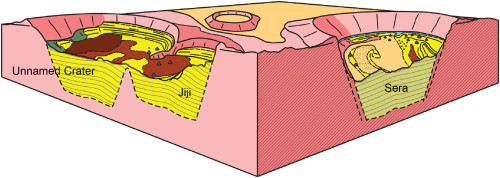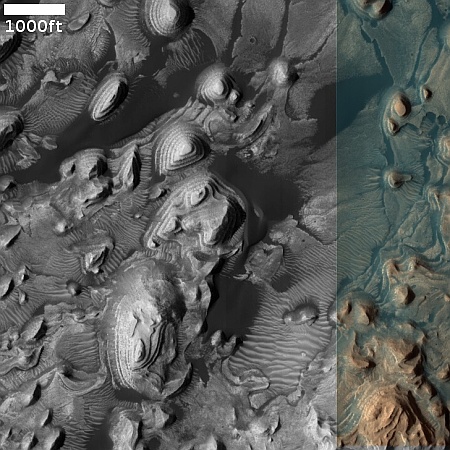Mapping the layered geology of Mars
Today’s cool image is an update of a previous cool image from July 2021. Then, I posted a captioned high resolution Mars Reconnaissance Orbiter (MRO) photo of the many terraced layers within a 13-mile-wide crater dubbed Jiji and located in Arabia Terra, the largest transition zone between the Red Planet’s northern lowland plains and the southern cratered highlands. At that time the caption noted that research was on-going to see if the same layers could be identified in two other nearby craters, Banes and Sera, and thus use that data to extrapolate the long term geological history of this region on Mars.
Today’s cool image to the right, rotated, cropped, reduced, and enhanced to post here, was taken on January 4, 2024 as part of this research, and shows the layers in 18-mile-wide Sera crater, located only about ten miles to the east of Jiji crater. The highest mesa near the bottom of the picture is about twenty feet high on its southern side, but about 140 feet high to the north. The difference is because the crater floor under the mesa is sloping downward to its lowest point to the north.


Figure 13 from paper. Click for original graphic.
The white dot on the overview map to the right marks the location of Sera crater, with the rectangle in the inset showing the area covered by the picture. The dark areas inside Sera of dust covered dune fields.
According to a paper published in March 2023, the geology of the layers in these two craters is linked, and appear to be also linked to the geological history of the larger surrounding region, as illustrated by the graphic below, figure 13 in the paper.
Layered deposits [LD] within Sera and Jiji preserve an exceptional record of past climatic conditions of the Arabia Terra region. Due to the thinning and thickening sequences identified from layer thickness measurements, mere subaerial deposition hypotheses (i.e., airfall deposition, volcanic or impact related ejecta) with no aqueous component is unlikely. We concluded that LD are deposited in an aeolian [wind-driven] environment controlled by a changing base-level of a near-surface aquifer. The variations observed in layering sequences likely reflect a significant control by groundwater-level fluctuations during deposition. The proposed long-term water level combined with the regional layer thickness trend does help support the idea that water level influences layer formation.
In other words, these terraces were formed from sand dunes blown here by wind, then compressed into rock layers that were later reshaped by a fluctuating water table of either water or ice.
As the location is now in the dry equatorial region, water or ice is no longer present, and hasn’t been for a very long time. All recent erosion is once again wind-driven.
On Christmas Eve 1968 three Americans became the first humans to visit another world. What they did to celebrate was unexpected and profound, and will be remembered throughout all human history. Genesis: the Story of Apollo 8, Robert Zimmerman's classic history of humanity's first journey to another world, tells that story, and it is now available as both an ebook and an audiobook, both with a foreword by Valerie Anders and a new introduction by Robert Zimmerman.
The print edition can be purchased at Amazon or from any other book seller. If you want an autographed copy the price is $60 for the hardback and $45 for the paperback, plus $8 shipping for each. Go here for purchasing details. The ebook is available everywhere for $5.99 (before discount) at amazon, or direct from my ebook publisher, ebookit. If you buy it from ebookit you don't support the big tech companies and the author gets a bigger cut much sooner.
The audiobook is also available at all these vendors, and is also free with a 30-day trial membership to Audible.
"Not simply about one mission, [Genesis] is also the history of America's quest for the moon... Zimmerman has done a masterful job of tying disparate events together into a solid account of one of America's greatest human triumphs."--San Antonio Express-News
Today’s cool image is an update of a previous cool image from July 2021. Then, I posted a captioned high resolution Mars Reconnaissance Orbiter (MRO) photo of the many terraced layers within a 13-mile-wide crater dubbed Jiji and located in Arabia Terra, the largest transition zone between the Red Planet’s northern lowland plains and the southern cratered highlands. At that time the caption noted that research was on-going to see if the same layers could be identified in two other nearby craters, Banes and Sera, and thus use that data to extrapolate the long term geological history of this region on Mars.
Today’s cool image to the right, rotated, cropped, reduced, and enhanced to post here, was taken on January 4, 2024 as part of this research, and shows the layers in 18-mile-wide Sera crater, located only about ten miles to the east of Jiji crater. The highest mesa near the bottom of the picture is about twenty feet high on its southern side, but about 140 feet high to the north. The difference is because the crater floor under the mesa is sloping downward to its lowest point to the north.


Figure 13 from paper. Click for original graphic.
The white dot on the overview map to the right marks the location of Sera crater, with the rectangle in the inset showing the area covered by the picture. The dark areas inside Sera of dust covered dune fields.
According to a paper published in March 2023, the geology of the layers in these two craters is linked, and appear to be also linked to the geological history of the larger surrounding region, as illustrated by the graphic below, figure 13 in the paper.
Layered deposits [LD] within Sera and Jiji preserve an exceptional record of past climatic conditions of the Arabia Terra region. Due to the thinning and thickening sequences identified from layer thickness measurements, mere subaerial deposition hypotheses (i.e., airfall deposition, volcanic or impact related ejecta) with no aqueous component is unlikely. We concluded that LD are deposited in an aeolian [wind-driven] environment controlled by a changing base-level of a near-surface aquifer. The variations observed in layering sequences likely reflect a significant control by groundwater-level fluctuations during deposition. The proposed long-term water level combined with the regional layer thickness trend does help support the idea that water level influences layer formation.
In other words, these terraces were formed from sand dunes blown here by wind, then compressed into rock layers that were later reshaped by a fluctuating water table of either water or ice.
As the location is now in the dry equatorial region, water or ice is no longer present, and hasn’t been for a very long time. All recent erosion is once again wind-driven.
On Christmas Eve 1968 three Americans became the first humans to visit another world. What they did to celebrate was unexpected and profound, and will be remembered throughout all human history. Genesis: the Story of Apollo 8, Robert Zimmerman's classic history of humanity's first journey to another world, tells that story, and it is now available as both an ebook and an audiobook, both with a foreword by Valerie Anders and a new introduction by Robert Zimmerman.
The print edition can be purchased at Amazon or from any other book seller. If you want an autographed copy the price is $60 for the hardback and $45 for the paperback, plus $8 shipping for each. Go here for purchasing details. The ebook is available everywhere for $5.99 (before discount) at amazon, or direct from my ebook publisher, ebookit. If you buy it from ebookit you don't support the big tech companies and the author gets a bigger cut much sooner.
The audiobook is also available at all these vendors, and is also free with a 30-day trial membership to Audible.
"Not simply about one mission, [Genesis] is also the history of America's quest for the moon... Zimmerman has done a masterful job of tying disparate events together into a solid account of one of America's greatest human triumphs."--San Antonio Express-News


